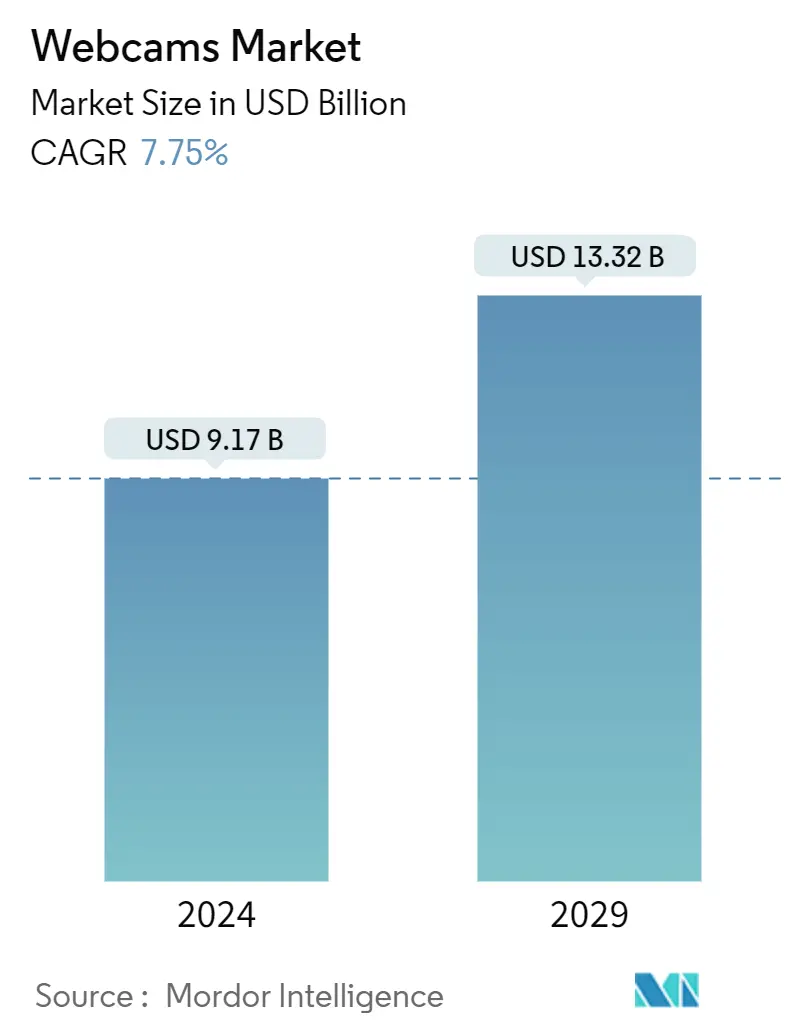Market Size of Webcams Industry

| Study Period | 2019 - 2029 |
| Market Size (2024) | USD 9.17 Billion |
| Market Size (2029) | USD 13.32 Billion |
| CAGR (2024 - 2029) | 7.75 % |
| Fastest Growing Market | Asia Pacific |
| Largest Market | North America |
| Market Concentration | Low |
Major Players
*Disclaimer: Major Players sorted in no particular order |
Webcams Market Analysis
The Webcams Market size is estimated at USD 9.17 billion in 2024, and is expected to reach USD 13.32 billion by 2029, growing at a CAGR of 7.75% during the forecast period (2024-2029).
The webcams industry is gaining prominence owing to the growing adoption of web cameras in security and surveillance, entertainment, video conferences, visual marketing, and live events.
- In the business sector, webcams are the most valuable business communication tools. Demand for webcams will rise during the projected period due to increased tendencies toward virtual office communication among professionals. The increasing use of webcams in the health industry for video conferencing and remote patient monitoring will likely drive market expansion.
- COVID-19 pushed most companies across the globe towards the hybrid work and work-from-home models. This WFH is now leveraged into a hybrid work culture after the pandemic, mandating the use of a webcam for daily meetings and activities. Furthermore, with the increased emphasis on remote working and hybrid work models post-COVID, the corporate environment is seeing a surge in demand for webcams. Video conferencing became the new norm for conducting business and client meetings. Webcam manufacturers are developing cameras with cutting-edge technology and features in response to changing client expectations and enhanced internet access.
- Additionally, the growing demand for surveillance systems for security and safety purposes and rising demand for automated guided vehicles (AGVs) and unmanned aerial vehicles (UAVs) across industrial and private sectors worldwide are the principal factors expected to drive the growth of the webcams market over the forecast period. Also, owing to several characteristics offered by webcams, such as vision control, command direction process, and decreased overheads, the webcam market is anticipated to grow.
- According to Guru99, the US and European markets account for 70% of the world's e-learning services users. 63% of students in the United States use online learning resources daily. A blended learning model was implemented by 21% of colleges. Online training is used by 50% of K-12 instructors. The usage of webcams might observe significant growth over some time.
- Internet speed directly affects the quality of images and videos recorded and streamed. Minimum internet speed is needed to avoid video distortion. Deployment of webcams is expected to witness slow growth in remote or distant locations and regions with weak internet connectivity, as fluctuations in internet speed act as restraints to market growth.
- Some known manufacturers are adding USB streaming support to their DSLR and mirrorless cameras, giving tough competition to the webcam companies. Cannon and Fujifilm include apps that let users use their cameras as webcams over USB. Canon's app works for Mac and Windows, while Fujifilm's is Windows-only. Canon developed new software, the EOS Webcam Utility, which turns Canon EOS SLR, mirrorless camera, or PowerShot compact into a USB webcam.
Webcams Industry Segmentation
Webcam can be used for simultaneous live voice and video discussions between two or more people. In addition to other applications, webcams are increasingly employed in security and surveillance, video conferencing, entertainment, live events, and visual marketing. Several popular real-time monitoring devices are employed to record ongoing events. Multiple cameras set at different angles continuously record inside and outdoor events. The study also tracks the key market parameters, underlying growth influencers, and major vendors operating in the industry. It supports the market estimations and growth rates over the forecast period.
The webcams market is segmented by webcam type (external and embedded) and by geography (North America, Europe, Asia-Pacific, Latin America, and Middle East and Africa). The market sizes and forecasts are provided in value (USD) for all the above segments.
| By Webcam Type | |
| External Webcam | |
| Embedded Webcam |
| By Geography | ||||||
| ||||||
| ||||||
| ||||||
| Latin America | ||||||
| Middle East and Africa |
Webcams Market Size Summary
The webcam market is experiencing significant growth, driven by the increasing adoption of web cameras across various sectors such as security, entertainment, video conferencing, visual marketing, and live events. The shift towards virtual office communication and hybrid work models, accelerated by the COVID-19 pandemic, has made webcams essential tools for business communication. This trend is further supported by the rising use of webcams in the healthcare industry for video conferencing and remote patient monitoring. The demand for webcams is also bolstered by the growing need for surveillance systems and automated guided vehicles, which are becoming increasingly prevalent in both industrial and private sectors. Additionally, advancements in webcam technology, including features like vision control and command direction processes, are contributing to market expansion.
The market is characterized by a competitive landscape with several major players focusing on expanding their global presence and enhancing their product offerings. External webcams, in particular, are witnessing substantial growth due to their superior image and audio quality, making them ideal for commercial applications such as video conferencing, e-learning, and security. The demand for webcams is further fueled by the increasing use of surveillance technology by government agencies and the rise in urbanization and consumer spending. North America stands out as a significant revenue-generating region, driven by the high adoption of online learning and distance education. The market is expected to continue its upward trajectory, with innovations and strategic collaborations playing a crucial role in meeting the evolving needs of consumers and businesses alike.
Webcams Market Size - Table of Contents
-
1. MARKET INSIGHTS
-
1.1 Market Overview
-
1.2 Industry Attractiveness - Porter's Five Forces Analysis
-
1.2.1 Bargaining Power of Suppliers
-
1.2.2 Bargaining Power of Buyers/Consumers
-
1.2.3 Threat of New Entrants
-
1.2.4 Threat of Substitute Products
-
1.2.5 Intensity of Competitive Rivalry
-
-
1.3 Industry Value Chain Analysis
-
1.4 Assessment of Impact of Covid-19 on the Market
-
-
2. MARKET SEGMENTATION
-
2.1 By Webcam Type
-
2.1.1 External Webcam
-
2.1.2 Embedded Webcam
-
-
2.2 By Geography
-
2.2.1 North America
-
2.2.1.1 United States
-
2.2.1.2 Canada
-
-
2.2.2 Europe
-
2.2.2.1 United Kingdom
-
2.2.2.2 Germany
-
2.2.2.3 France
-
2.2.2.4 Rest of Europe
-
-
2.2.3 Asia Pacific
-
2.2.3.1 China
-
2.2.3.2 Japan
-
2.2.3.3 India
-
2.2.3.4 Rest of Asia Pacific
-
-
2.2.4 Latin America
-
2.2.5 Middle East and Africa
-
-
Webcams Market Size FAQs
How big is the Webcams Market?
The Webcams Market size is expected to reach USD 9.17 billion in 2024 and grow at a CAGR of 7.75% to reach USD 13.32 billion by 2029.
What is the current Webcams Market size?
In 2024, the Webcams Market size is expected to reach USD 9.17 billion.

